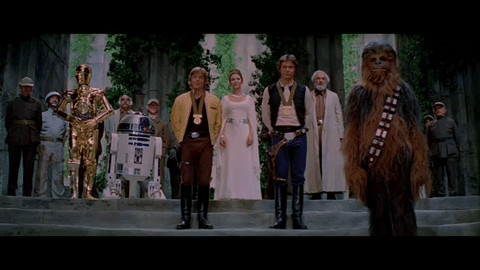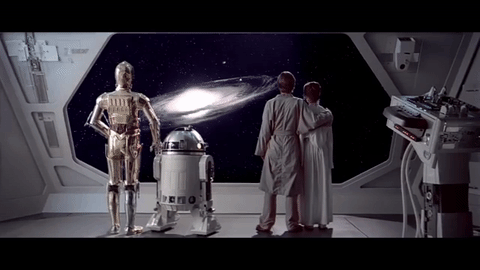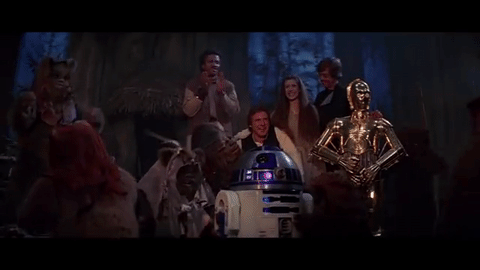(In case it wasn’t clear from the headline, this post will spoil the ending of Star Wars: The Force Awakens.)
For its first 131 minutes, the new Star Wars movie, The Force Awakens, devotes itself so fully to the spirit of the original trilogy that its devotion almost feels like worship. Props from the original movie—Luke’s lightsaber, Vader’s mask—are held up like sacred relics. Its plot processes through the stations set down by the 1977 Star Wars one by one—sand planet, Millennium Falcon, cantina outpost, the death of the father figure, and the destruction of Death Star—as if re-enacting an ancient ritual. I imagine co-writer and director J.J. Abrams kneeling before a projection of A New Hope and uttering, “Yes, Master.”
And at that 131st minute (I’m estimating), the movie almost comes to a close with the perfect Star Wars sign-off. All our surviving heroes are at last reunited, after the big battle, and they stand in a line facing the camera, as if taking a final bow. It starts to feel like the ending of every other Star Wars movie, and I was ready for The Force Awakens to iris out and roll credits. In nomine patris, et filii, et spiritu Kenobi.

The ending of Star Wars: Episode IV – A New Hope. GIF by the author.

The ending of Star Wars: Episode V – The Empire Strikes Back. GIF by the author.

The ending of Star Wars: Episode VI – The Return of the Jedi. GIF by the author.
But then Rey takes off—and the movie keeps going.
It’s at this precise moment that The Force Awakens ceases to feel like a Star Wars movie and begins to feel like something else. Specifically, it was at this moment that I began to remember that Lucasfilm is now a subsidiary of Walt Disney Pictures, the same mega-studio that presides over the Marvel movies. The Force Awakens might not a have a post-credits sequence in which Samuel L. Jackson shows up as Mace Windu to invite Rey to join the Jedi Initiative, but it has the same type of teaser in the form of its final five minutes.
Fans may differ about whether this alteration of the Star Wars formula is a misstep or an improvement. After all, what follows is a pretty good scene. In addition to giving Luke a fitting reintroduction (is he our new Yoda or Obi-Wan?), the scene creates a nice rhyme with the movie’s climax, when Kylo Ren begins to hand over his lightsaber, forcing a moment of trust and vulnerability between a young Jedi and a father figure. The ending raises similar questions. Can we trust Luke? Can Luke trust Rey, or will she turn against him just like Ren? Are they, too, related?
The cliffhanger teaser also has precedent in Star Wars’ ancestry. As I noted in my essay on Star Wars’ origins as a pastiche, George Lucas’ second-draft screenplay for the original film (then titled Adventures of the Starkiller) had it ending with a teaser for the next episode, just like an episode of Flash Gordon:
The Starkiller would once again spark fear in the hearts of the Sith knights, but not before his sons were put to many tests … the most daring of which was the kidnapping of the Lars family, and the perilous search for:
“The Princess of Ondos.”
Of course, Lucas ultimately decided against including any cliffhanger or teaser, perhaps realizing that it would distract from the movie itself.
For me, this was a great scene that belonged in the next movie. It felt less like part of The Force Awakens then a “Next week, on Star Wars”-style preview of—or advertisement for—things to come. The most common complaint about the new movie is that it has no new ideas; it’s just a remix of A New Hope. That’s my biggest reservation about it, too. But if the new movies want to feel truly fresh, they’re going to have to do more than borrow conventions from Marvel.
